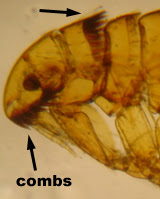Identification (genus and species)? Tunga penetrans or "jigger" flea
What disease does this arthropod cause? Tungiasis.
This is the only flea that buries into human skin to lay its eggs.
Fleas can be tricky to identify if you're not familiar with them. Here are a few ways to tell this flea apart from others seen in association with humans:
As seen below, Tunga penetrans is a very distinctive flea (click on image to enlarge). It has a compressed thorax, upturned rear, and long serrated mouthparts (all the better to pierce your skin).

Compare T. penetrans to Xenopsylla cheopsis (pronounced Zee-nopp-se-la chee-op-sis). Note the rounded rear, uncompressed thorax, and normal sized mouthparts. X. cheopsis is the Oriental Rat flea; carrier of the bacteria Yersinia pestis (cause of the plague) and Rickettsia typhi (endemic or murine typhus).

Finally, other fleas that may be seen in association with humans are Pulex irritans (the aptly-named human flea, which actually infests many different animals including humans), Ctenocephalides canis (dog flea), and Ctenocephalides felis (cat flea). The latter two will bite humans when their animal hosts are not available. My thanks to "anonymous" who reminded me that Ctenocephalides can transmit dipylidium caninum to humans (usually children)
Note that Ctencephalides fleas often have "combs" - what appear as a mustache (genal comb) and head fringe (pronotal comb) in the example below.




1 comment:
cannot forget dipylidiasis transmitted by Ctenocephalides
Post a Comment